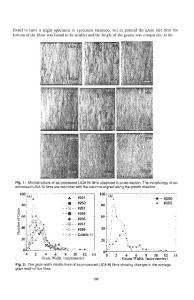Microstructures and Mechanical Properties of Biomedical Co-29Cr-6Mo-0.14N Alloys Processed by Hot Rolling
- PDF / 1,493,544 Bytes
- 12 Pages / 593.972 x 792 pts Page_size
- 77 Downloads / 392 Views
TRODUCTION
AS the problems associated with an aging society have been increasing in Japan in recent years, there has been increasing interest in biomaterials, which can be used as substitutes to perform the functions of the human body. These materials are being researched and developed intensively. One class of these materials is metals. Because they offer a better balance of strength and toughness than polymers and ceramics, they are used for hard-tissue replacements that support the body. The main metallic biomaterials that are used currently are pure titanium, titanium alloys, austenitic stainless steels, and cobalt-chromium-molybdenum (Co-Cr-Mo) alloys. Of these materials, Co-Cr-Mo alloys are important as materials for artificial hip and knee joints because they have superior corrosion and wear resistance than other metals.[1] Recently, they attracted interest as materials for stents because of their high elastic modulus and low radiolucency. Furthermore, their low magnetic susceptibility ensures that they do not cause artifacts readily in magnetic resonance imaging.[2] Of the Co-Cr-Mo alloys used in biomedical applications, those used for artificial hips and other joints are primarily cast alloys standardized in ASTM F75. ASTM F799 has also been standardized; it has the same composition as ASTM F75, but it has superior mechanical properties because of hot forging. However, MANAMI MORI, formerly Graduate Student, with the Institute for Materials Research, Tohoku University, Sendai 980-8577, Japan, is now Researcher with NISSAN ARC, LTD., Yokosuka 237-0061, Japan. KENTA YAMANAKA, Ph.D. Student, SHIGEO SATO, Associate Professor, KAZUAKI WAGATSUMA and AKIHIKO CHIBA, Professors, are with the Institute for Materials Research, Tohoku University. Contact e-mail: [email protected] Manuscript submitted August 16, 2011. Article published online April 5, 2012 3108—VOLUME 43A, SEPTEMBER 2012
the typical composition in ASTM standards (e.g., Co-29 Cr-6Mo (mass pct*) alloy) readily undergoes a *In this article, all alloy compositions are expressed in mass pct.
martensitic transformation during quenching after solution heat treatment. Consequently, it has a duplex structure of a face-centered cubic (fcc) metastable c phase and a hexagonal close-packed martensitic e phase at room temperature. This makes it difficult to obtain a sufficiently high cold workability (edge cracking commences at a rolling reduction of ~5 pct[3]). In addition, such a low workability is also problematic for microstructure control through thermomechanical processing, which is used to improve the mechanical properties. Thus, a large amount of Ni (10 to 37 pct) is added to stabilize the c phase and Co-Ni-Cr-Mo (ASTM F562) and Co-Cr-Ni-W (ASTM F90) alloys are generally used for stents, which requires processing into sheets, smalldiameter pipes, or wires. However, Ni has detrimental effects on the body; it can be carcinogenic or cause metal allergies. Moreover, because stents are long-term implants (i.e., once they have been installed inside the body, they
Data Loading...











